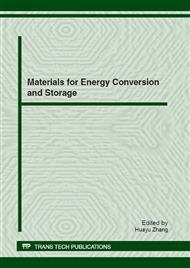p.1
p.6
p.10
p.14
p.20
p.24
p.28
p.32
p.36
Preparation and Properties of Polyamide 6-Functionalized Nanometer-Sized Graphene Composite Fiber
Abstract:
A novel approach to the functionalization of nanometer-sized graphene was presented in this work. Covalent bonding between the filler and matrix was formed, with minimal disruption to the sp2 hybridization of the pristine graphene sheet. Functionalization proceeded by covalently bonding a 4-substituted benzoic acid monomer to the surface of expanded graphene, via ‘‘direct Friedel-Crafts” acylation in mild reaction medium of polyphosphoric acid (PPA)/phosphorous pentoxide. Polyamide 6 (PA6)-functionalized graphene (FG) composites were prepared by in situ polymerization of ε-caprolactam in the presence of nanometer-sized FG. Nanocomposite fiber with 0.1 wt.% content of nanometer-sized FG was prepared with a piston spinning machine and hot-roller drawing machine. The nanometer-sized FG performed homogeneous dispersion in the polymer matrix. The mechanical properties of the PA6-FG composites fiber was enhanced by adding FG in the polymer matrix. The new functionalization method paves the way to prepare graphene-based nanocomposites fiber simply, without disrupting the primary structures of nanometer-sized graphene.
Info:
Periodical:
Pages:
20-23
Citation:
Online since:
July 2012
Authors:
Price:
Сopyright:
© 2012 Trans Tech Publications Ltd. All Rights Reserved
Share:
Citation:



